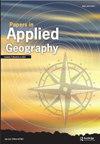Long-term evaluation of land surface temperature with bare surface index and surface vegetation index: a case study of a central Indian city
Q2 Social Sciences
引用次数: 0
Abstract
Abstract Bare surface index (BSI) and surface vegetation index (SVI) are important spectral indices for land use planning systems. A long-term monthly analysis of BSI and SVI in an urban area is needed for better land use planning. However, a few research works were available on BSI and SVI. The present research work evaluates the mean monthly land surface temperature (LST) and the monthly LST-BSI and LST-SVI correlation in Raipur City of central India using 254 Landsat satellite data from 1988 to 2019. April (37.11 °C) and January (24.11 °C) record the highest mean LST and lowest mean LST, respectively. Karl Pearson’s coefficient of correlation is used to correlate LST with BSI and SVI. Although both the indices develop a positive correlation (moderate) with LST, BSI (0.64) has a better value of correlation coefficient than SVI (0.39). The best LST-BSI correlation is found in August (0.77) followed by September (0.75), October (0.74), and July (0.72). The best LST-SVI correlation is also observed in August (0.50), followed by July (0.49) and September (0.48). The study indicates that a dry bare surface enhances the intensity of LST. The research may be considered a good case study for land use planners.利用地表指数和地表植被指数对地表温度的长期评价:以印度中部城市为例
本文章由计算机程序翻译,如有差异,请以英文原文为准。
求助全文
约1分钟内获得全文
求助全文

 求助内容:
求助内容: 应助结果提醒方式:
应助结果提醒方式:


